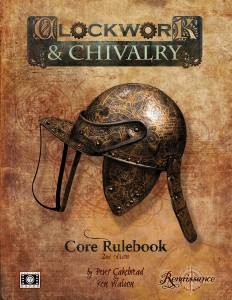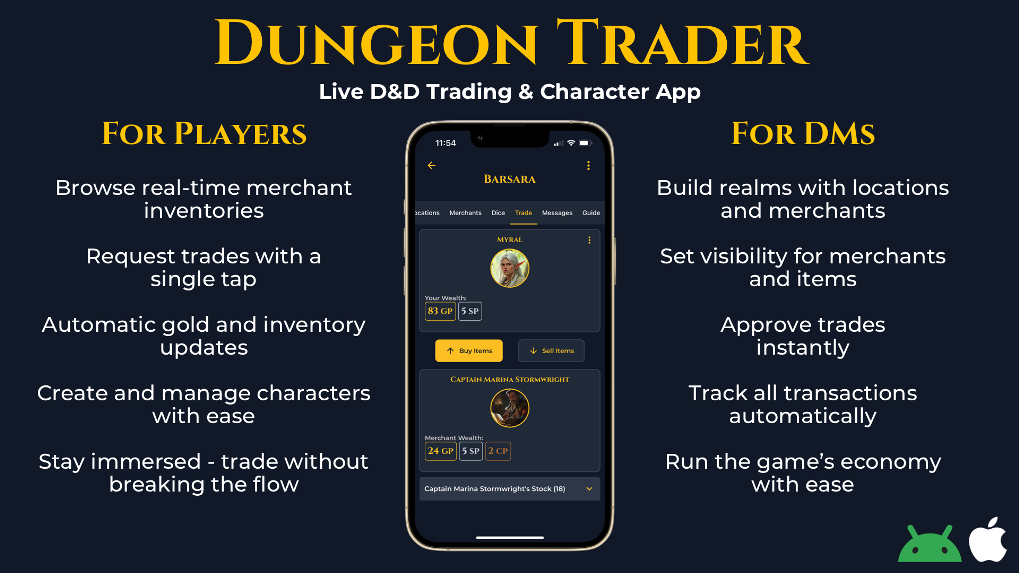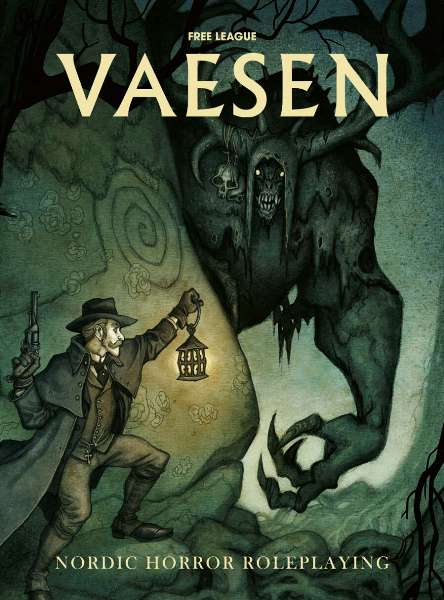Clockwork & Chivalry Part 1: First Impressions
By Aaron T. Huss

Learn more about Clockwork & Chivalry here
Welcome to part 1 of the Featured Product series for Clockwork & Chivalry, published by Cakebread & Walton. Part 1, First Impressions, takes a look at the product series as a whole in both RuneQuest II and Renaissance incarnations.
SYSTEM & SETTING
Clockwork & Chivalry is a beautiful blend of history, sci-fi, and fantasy by taking an historical period, namely the English Civil War during the mid-17th century, and mixing it with alchemy fantasy and clockwork science fiction. Following its initial release as being a RuneQuest II world book, Clockwork & Chivalry is now offered as a standalone book powered by the black powder fantasy system called Renaissance. While the Renaissance system is offered as a free SRD and a deluxe version for purchase, all necessary rules are contained within the Clockwork & Chivalry core rulebook.
The Renaissance game engine is a d100 system built on the RuneQuest, RuneQuest II (now Legend), and OpenQuest foundation. It takes a lot of influence from all the parent systems, uses the mechanics which fit best, and adds a lot of flavor to properly set it within Earth’s historical Early Modern Age (hence the black powder) with a slight mixture of fantasy. I say slight because the fantasy elements of Renaissance are not over-the-top or in-your-face.
One thing to keep in mind, is that this version of Clockwork & Chivalry is the second iteration of the game setting due to Mongoose Publishing’s loss of the RuneQuest license and Cakebread & Walton’s desire to build the second edition upon their own setting. What that means is a lot of the little errors and what-not from the first edition have been cleaned up for this edition.
Compared to the first edition, the second edition has an improved layout and incorporates some of the content previously scattered about throughout different places (such as the Witchcraft rules). This means the core rulebook is quite the mighty tome, coming in at 400 pages. Do not fret at this page count, though, everything necessary to run a Clockwork & Chivalry game is contained within. You get a large quantity of character options considering Social Class, Professions, and Factions.
When approaching Clockwork & Chivalry, or the Renaissance system, look closely at the mechanics for using Factions and Righteousness. This is an interesting feature built into the core mechanics to help flesh out the social, political, and religious interaction between characters. As is evident from the Clockwork & Chivalry setting, there was a lot of social turmoil throughout the English Civil War, and how would you go about representing that? That’s where factions come in. This type of social mechanic is not only a great way to introduce non-combat encounters into your regular adventures, it’s a powerful tool for leading campaigns and can even be used for instant adventure hooks as one faction clashes with another as the adventuring party wanders into a village.
As a fan of history, and alternate history, games that approach historical eras in a complete fashion are quite desirable. Clockwork & Chivalry isn’t simply a fantasy clockwork setting placed within the Renaissance era, this is an actual setting built around the conflicts of the time with an alternate history flair. Historical events are explained with a Clockwork & Chivalry flair such as the Royalists using alchemy and the Parliamentarians using clockwork. There is a general sense of one versus another in social, political, and technology aspects. Add to this the various factions that support each side or stand in the middle, and you have a very complete setting with all the mechanics to support it.
SUPPORT
Clockwork & Chivalry is not in its infancy, one of the reasons I chose it. The original edition was supported by the Kingdom & Commonwealth campaign (the first four books out of a total of six) and the new edition is supported by revisions to those four books (in the form of two compendiums) for the update to Renaissance. The original edition was also supported by the Divers & Sundry supplement, most of which has been incorporated into the new core rulebook.
However, as a highlight, I’d like to reference Clockwork & Cthulhu. Clockwork & Cthulhu is a layer that can be added to Clockwork & Chivalry to bring the Cthulhu Mythos into your games, with some added mechanics for supporting the horror theme. I say layer because it truly sits atop the core mechanics by offering new factions to be a part of, and only introducing a small amount of mechanics to use with this new layer. Characters from both settings can be used between the two, and this new layer focuses more on what’s been added to the core system and setting rather than replacing what’s already there. In fact, the characters I created for this Featured Product series were done with Clockwork & Cthulhu in mind to get the full feel of the system and this added layer. I then ported them to the core setting flawlessly with no need to make any additional changes. I was quite impressed with how the two mesh and the only thing I needed to do extra, due to how I designed the characters, was add an extra layer of “Mythos faction” to represent how the characters have an alignment that the general populace is oblivious to. I did this for flavor rather than as a requirement, and find the execution to be awesome! If you want to amp up the horror in your games, Clockwork & Cthulhu is the perfect layer to add.
NEWCOMERS
For those unfamiliar with Clockwork & Chivalry, it is imperative to have an understanding for what the setting means and how the game system relates to it. Adventures and campaigns are not designed to save the world (although you could), they’re not going to be epic fantasy with loads of magic, they’re not going to contain lots of high-technology that doesn’t make sense. In fact, the stories are set within a history pretty much parallel to our own. This means that you only need to look as far as historical fact to create a lead-in to your adventures and mix it up a bit with the mechanics contained therein. There is a definite underlying theme to how Clockwork & Chivalry approaches the gaming experience and to get the full effect, it’s good to know what’s inside.
So what does this mean? Read the setting information within the book, try to better understand the use of factions, and design characters that are as much a part of the setting as they are your ideal creation. Within Clockwork & Chivalry, the setting is as much of the game as the game itself. The setting is there to wholly absorb the characters into and not just serve as a background, like many fantasy settings do. You can do this by involving the adventuring party in historical events or whatever is taking place within the historical locations to make the characters feel as though they are truly a part of this history. Conflicts generally have a purpose, and you won’t find the random dungeon to simply crawl through and collect gold. In fact, collecting treasure is one of the least important things in Clockwork & Chivalry. This is a game and setting that focus on the story and how the characters interact with it. Don’t be afraid to take history and turn it on its head!



